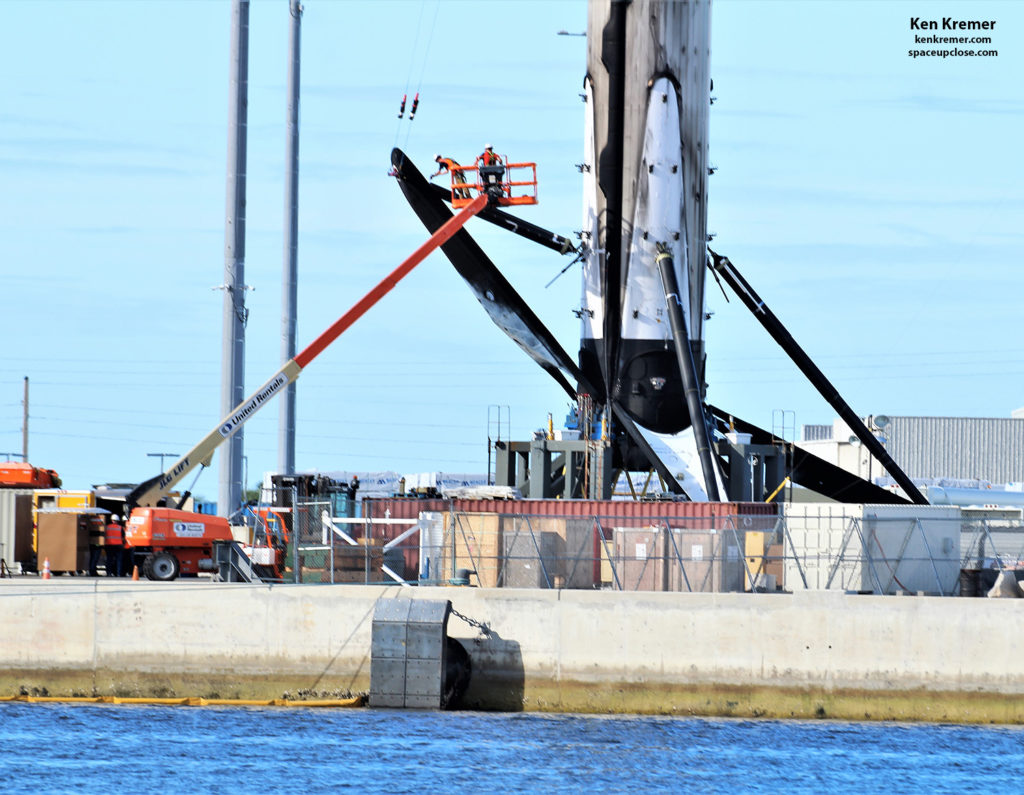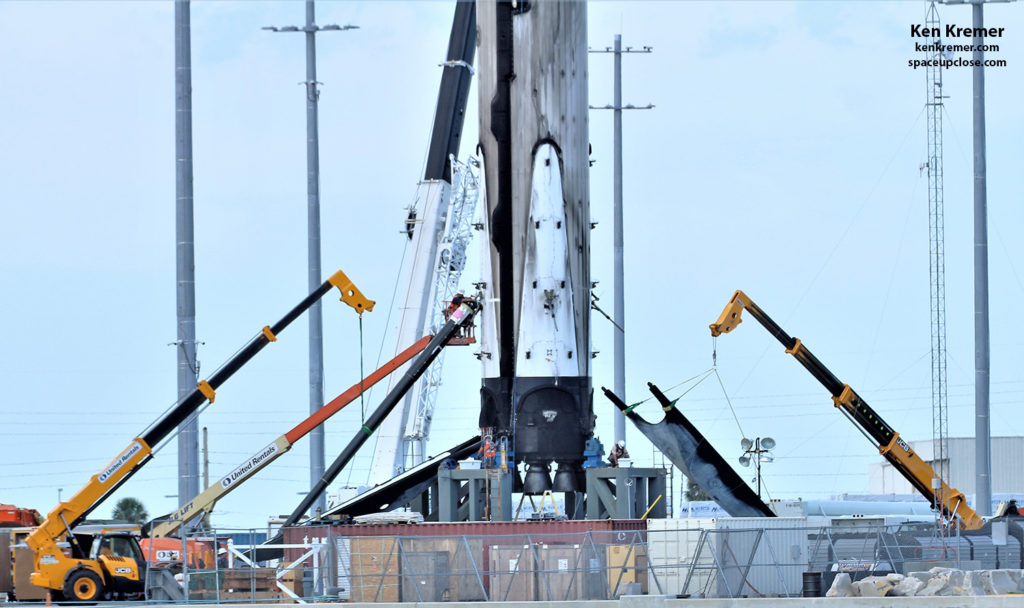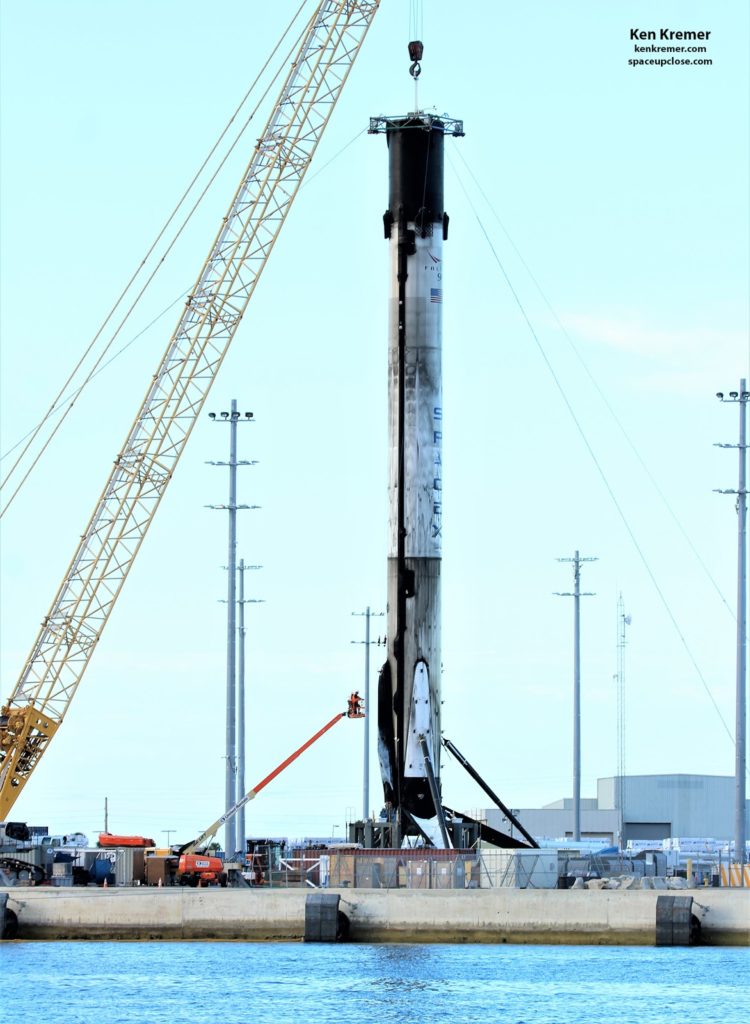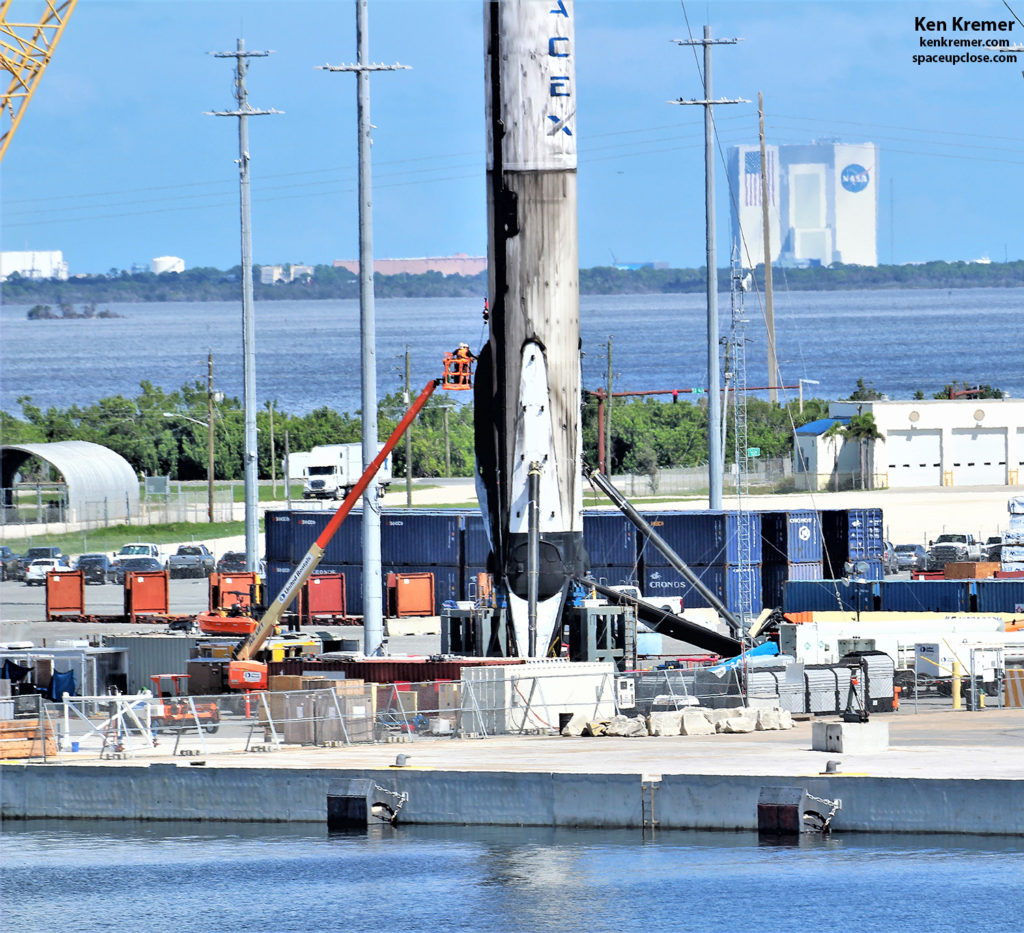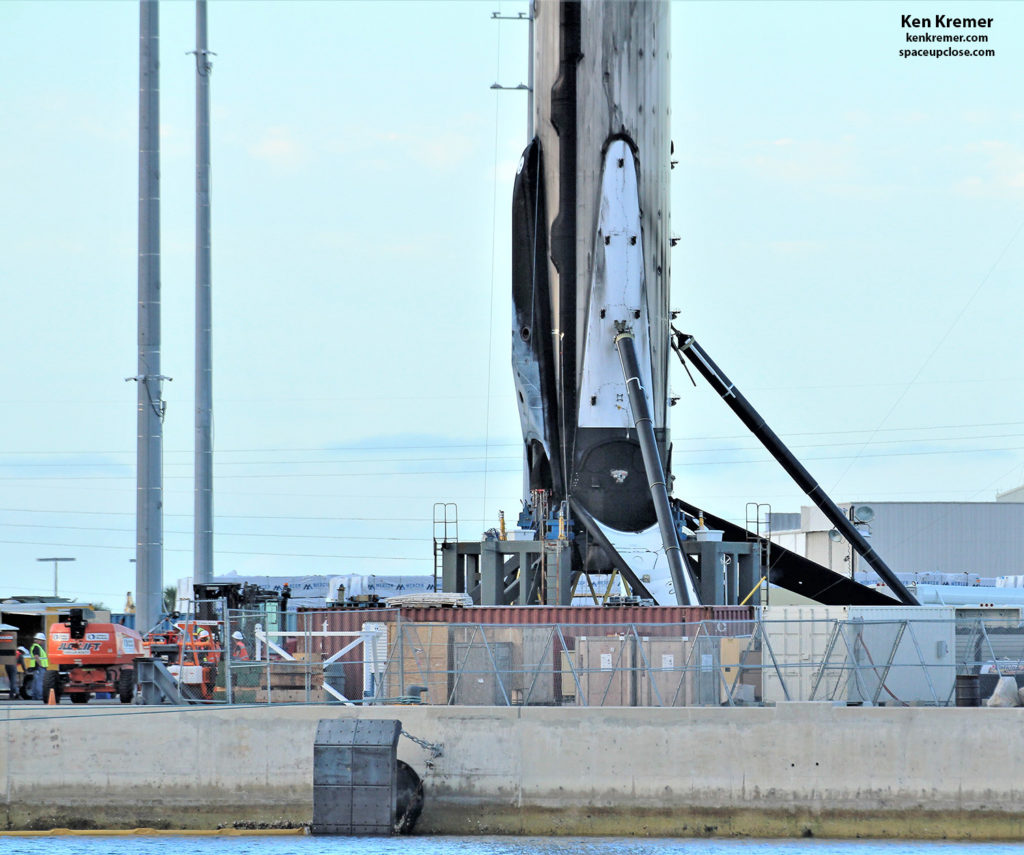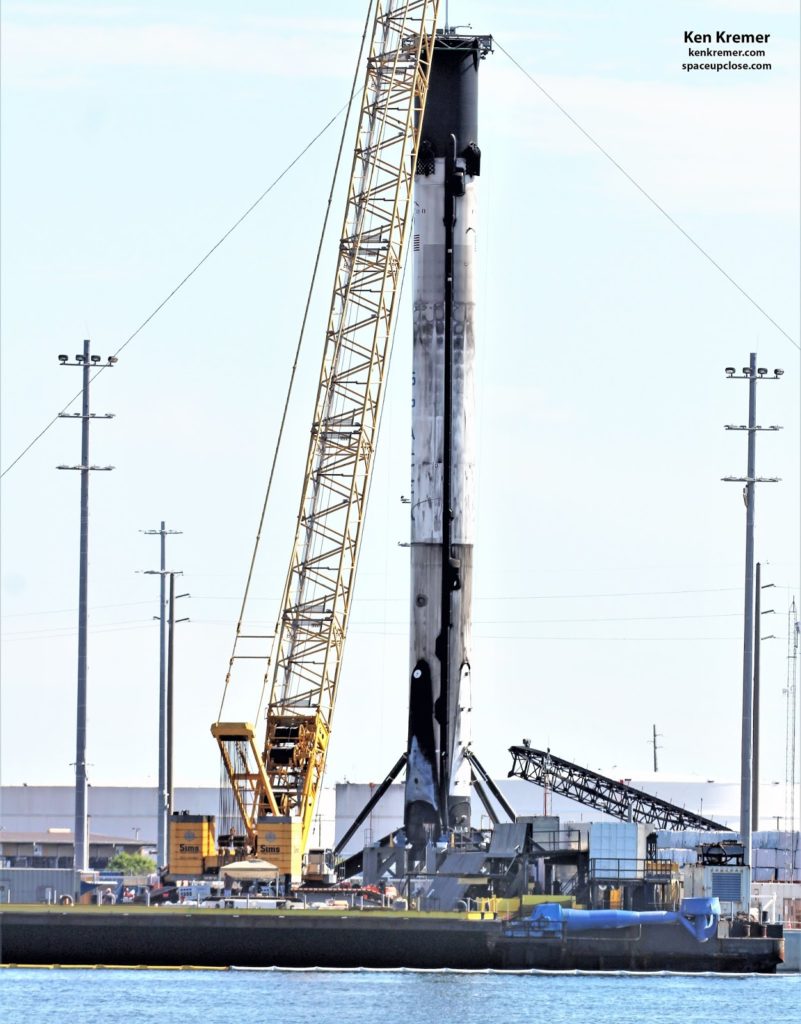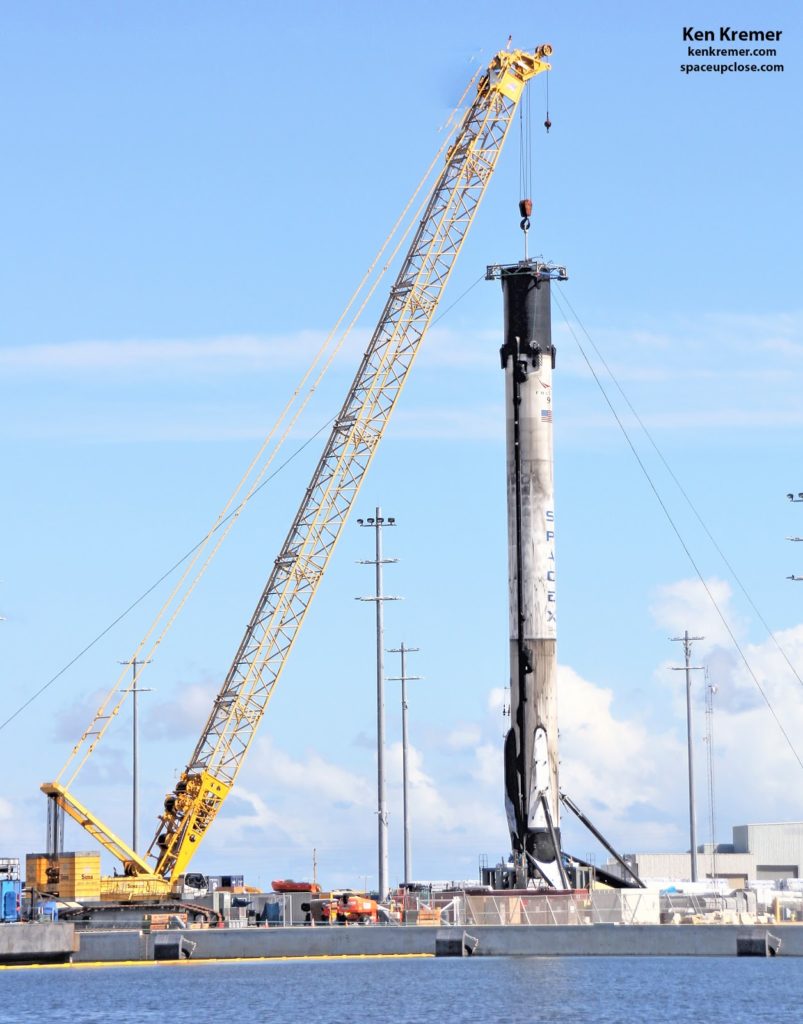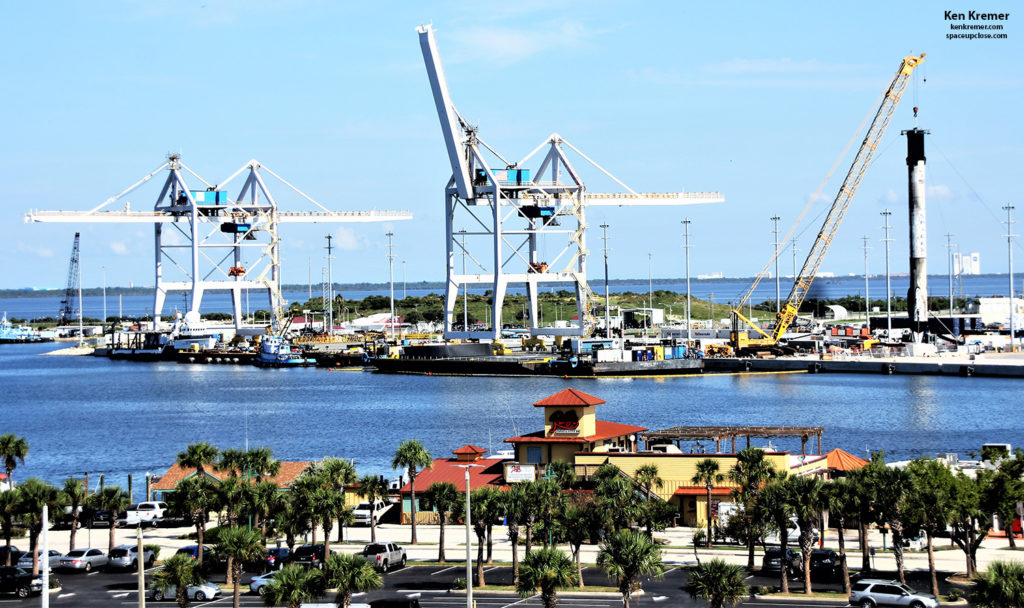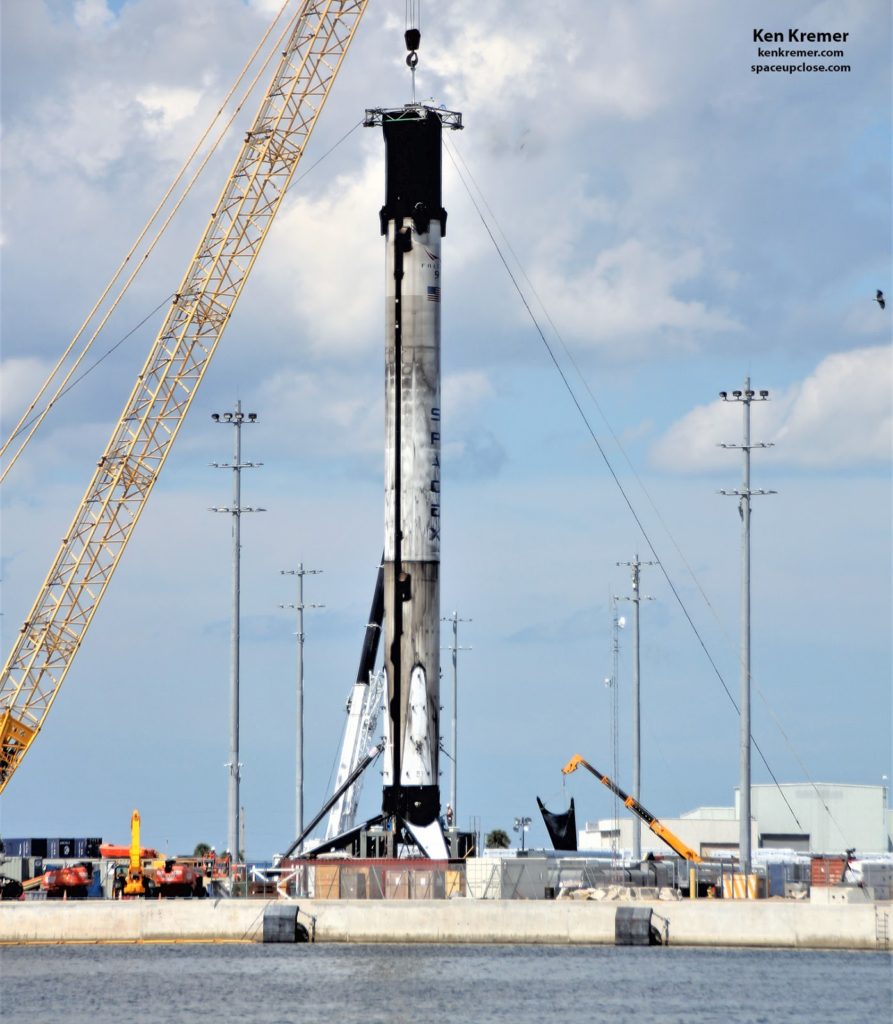Ken Kremer
— SpaceUpClose.com — 15 September 2018
PORT CANAVERAL, FL – Craneworkers have gone ahead and completely detached
all landing legs from the recently recovered Falcon 9 1st stage after
encountering a numbers of issues that repeatedly interrupted initial plans to
retract the legs – thus illustrating that the retraction process remains
experimental at this time and is not yet ready for prime time, as I observed over
a multi-day period this week in Port Canaveral, Florida.
SpaceX engineers in concert with the
crane crews apparently determined that leg removal rather than leg retraction up
against the 15-story tall core remains the best course of action, at least for
now while they work out the kinks – with respect to the upgraded Block 5 model first
stage boosters that propulsively soft land on a vessel at sea after launching
and carrying their payload to orbit.
Check out my Space UpClose gallery
of eyewitness photos detailing the landing leg retraction, re-lowering and
ultimately dissection/detachment of all four legs, utilizing
what we call the ‘Booster Lift/Leg Retraction Device’ or BLLRD. Also watch the high-resolution
videos provided by US Launch Report.
left side landing leg fully flush against the core – two times overall – but
only after pausing many times and manually intervening to make measurements with
what looked like tape measures and touching the struts and landing pads for
unknown reasons – very likely in real time consultation with engineers at
SpaceX HQ evaluating how best to proceed forward.
the retraction upward process mid way through and actually re-lowered the leg
before finally re-raising the leg completely during a lengthy operation of fits
and starts which took a little more 90 minutes, Thursday morning, Sept. 13.
struts and pads deformed ever so slightly and
got stuck during retraction due to the severe aerodynamic forces of
the Telstar 18v launch and landing and their design may need to be refined.
barely three days after a SpaceX Falcon 9 rocket blasted off early Monday,
Sept. 10 and successfully delivered the powerful Telesat 18v telecommunications
to orbit, and then subsequently landed safely upright on an ocean going
platform in the Atlantic Ocean.
Only two days after blastoff the
recovered first stage booster sailed into Port Canaveral Wednesday September 12
– beating out the then approaching deadly menace of Hurricane Florence.
The sooty booster was towed into
Port Canaveral atop the “Of
Course I Still Love You” (or OCISLY)
drone ship platform upon which it landed Monday
and that was prepositioned some 400 miles (640 km) off shore in the Atlantic
Ocean. Check out our story and photos.
Landing leg retraction was touted by
SpaceX CEO and billionaire founder Elon Musk as a key improvement milestone toward
the goal of achieving far faster turnaround of ‘Flight-Proven’ first stages for
the significantly improved Block 5 version Falcon 9 vs. the older and now
retired Block 4 first stages.
In fact Musk said he aims for his
SpaceX team to launch, land and relaunch the same booster within a 24 hour
period.
After docking the droneship at the port
the crew installed a cap at the top of the booster that we are dubbing the
Booster Lift/Leg Retraction Device (or BLLRD).
The square shaped cage-like BLLRD apparatus
consists of pullies, cables, stabilizers and an adjustable circular hoisting cap
that can all be operated remotely.
An earlier, simpler version of the hoisting
cap required the crane workers to pull the cables down manually on cherry
pickers. A series of four sets of cables are used to attach to the ground for
stabilization. Another set of two cables is manually attached to the tip of the
landing pad to enable retraction by rotating the pully’s.
With the BLLRD firmly attached atop,
the team comprised of some two dozen or so workers hoisted the sooty booster
off OCISLY
and onto a cradle mounting platform on land Wednesday afternoon, Sept. 12. Check out our story and photos.
The crane operations team then set
about to raise the left side landing leg.
Starting early Thursday morning Sep.
13, the team used the BLLRD to try and retract the left side landing leg – as I
watched from across the narrow channel in Port Canaveral.
Eventually they succeeded, but only
after many starts and stops.
Surprisingly, the retraction operation
for this booster took some 90 minutes from about 9:30 am to 11 am EDT – more than
twice as long as the same operation took for the recovered Telstar 19v booster
back in late-July lasting about 40 minutes.
Even more surprisingly the team then
redeployed the left leg in a free fall operation by gravity, that took some 2.5
seconds – just like a real landing! The
leg bounced and shuddered for a few moments after it fully extended around 1230
p.m..
So we wondered what would happen next-
detachment or another retraction experiment?
Well the powers to be decided to retract
that same left side leg again Thursday afternoon. The results and timing were
the same.
Overall the 2nd
retraction took some 90 minutes, was interrupted for manual action by the team
as the leg was partially raised, then lowered and finally raised fully flush snugly
against the core starting about 445 p.m.
and concluding a very long and intensive day of operations at about 6:20 p.m.
Sep 13.
end of the retraction experimentation because the next day, Friday, Sept. 14,
the crews went about unbolting, detaching and dissecting off all four legs.
But first they again commanded a
gravity drop of the retracted left landing leg that took about 2.5 seconds at
12:30 p.m.
It then took about 3 hours to remove
all 4 landing struts and all 4 landing pads.
Watch this high resolution video detailing
the landing leg retraction and removal operations from US Launch Report:
Each landing leg strut was carefully
slung on a harness and craned away. Similarly they set to work detaching the landing pads
using an even larger harness and larger crane.
In contrast to earlier leg removals,
the teams were simultaneously detaching struts and landing pads from different landing
leg at the same time – in a remarkably well choreographed operation that was
fascinating to watch with multiple loaded cranes moving at once in different directions.
Thus Musk’s hoped for goal of raising
all four landing legs back up and locking then in place flush against the core exterior
will have to wait until the retraction kinks are work out for a future launch
and landing opportunity.
Watch for Ken’s continuing onsite coverage of NASA, SpaceX, ULA,
Boeing, Lockheed Martin, Orbital ATK and more space and mission reports direct
from the Kennedy Space Center, Cape Canaveral Air Force Station, Florida and
Wallops Flight Facility, Virginia.
Stay tuned here for Ken’s continuing Earth and Planetary science and human
spaceflight news: www.kenkremer.com
–www.spaceupclose.com – twitter @ken_kremer – email: ken at kenkremer.com
Ken’s photos are for sale and he is available for lectures and outreach events


